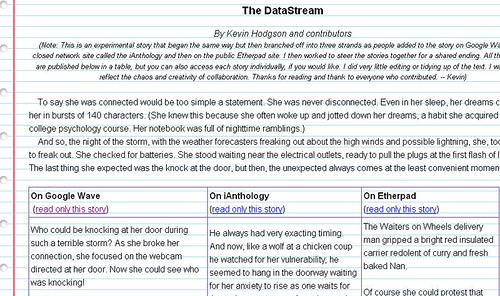The three strands of this week’s collaborative storytelling — in Google Wave, on an Etherpad site, and in a closed network of teacher-writers — were brought to an end this morning as I wrapped up the adventures under the title The Datastream.
You can read all three stories together on a Google Docs website that I created. You also have the opportunity to read each story on its own through links that I put on that master document.
I did very little editing or tidying up of the text, although I wanted to re-form the stories to make more sense as we neared the end. That was the editor in me. I resisted the urge, figuring that the way the stories get tangled and untangled is interesting in itself, and part of the process, and I did not want to lose the various voices of the collaborators. I loved how links, images, even Twitter, became part of the Wave story.
I struggled with how to end the three stories, even as I tried to steer the narrative towards each other in the last day or two. It became a science fiction-ized story at that point because I could not see any other way to bring the stories together and to a close. What I did not want was a project that never ends.
Ending are as important as beginnings, right?
I decided that I would write the ending piece as second-person narrative — an attempt to draw the reader into the collaborative experience as much as the writers (and there were more than 20 writers across the platforms collaborating on different strands of the story).
So, the obvious question: does this kind of collaborative story have a place in the classroom?
Absolutely, and as Tracy wrote about on her blog, you don’t need technology. Simply having students write the start of a story on paper, and then pass that paper around the room two or three times (it’s a good way to have them think about plot — one person does exposition, another person takes on rising action, etc.).
A few years ago, I used a wiki for this kind of student collaborative writing over a vacation and the students loved it, although the story made no sense whatsoever. Perhaps it would be good to designate some “student editors” of the story, to do sort of what I did here — gently shaping it.
This story project began because I wanted to know what Google Wave was all about. I figured a collaborative story might make sense, and I did learn a lot about Wave from the story writing. I don’t like Wave all that much but I learned how to use it. Then, it occurred to that I am part of a writing community already — the iAnthology — and why not draw them into the concept? So, a second strand began. Someone complained that they could not access Wave, so I started a third strand over at Etherpad, an online word processor that requires no registration.
You should have seen me bouncing around between the three stories, trying to keep plot lines and characters straight in my head. It was fun but strange, as if I were dancing with three partners to three different styles of music, all at once.
If you were a participant in this particular collaborative adventure, I want to thank you. If you are just a reader, thanks, too. We’re in this together, you know.
Peace (in the stories),
Kevin

I’m curious why you didn’t like Wave all that much. I’m learning to use Wave myself. Thanks for any insight or explanation.
Hi Keith
I found Wave to be slow and nothing more than a modified Wiki, really. It is nice that you can add some tools to the waves, but one thing I didn’t like (or could not find) is a way to message everyone in a wave so that they would know to come back to read and write.
For me, Wave seems all hype and little use, but it is still in Beta and perhaps a future upgrade will make it more viable.
What about you? Do you like wave?
Kevin
Kevin,
What an interesting piece of work here! I am going to read the stories later, as I need to get my act in gear for work (sigh, the 2 week break went by as quickly as it does every year!).
I’m wondering how the stories reflect the different communities they came from, though I guess the iAnthology group is the only one that was a cohesive community to begin with.
I like this idea, something to do with testing out improv in the class, in a kind of safe way for students as it is written, not said or performed.
Thanks for giving us the opportunity to participate!
Tracy